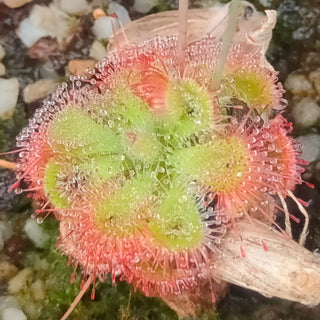Iris pseudacorus variegata
VARIEGATED IRIS
- Unit price
- / per
These seeds are for the variegated form, leaves are green and creamy-white.
Iris pseudacorus (yellow flag, yellow iris, water flag) is native to Europe, western Asia and northwest Africa.
It is an herbaceous flowering perennial plant, growing to 100-150 centimetres (39-59 in) (or a rare 2 metres (6 ft 7 in)) tall, with erect leaves up to 90 centimetres (35 in) long and 3 centimetres (1.2 in) broad. The flowers are bright yellow, 7-10 centimetres (2.8-3.9 in) across, with the typical iris form. Iris pseudacorus grows best in very wet conditions, and is often common in wetlands, where it tolerates submersion, low pH, and anoxic soils. While it is primarily an aquatic plant, the rhizomes can survive prolonged dry conditions.
The plant was rated in second place for per day nectar production per flower in a UK plants survey conducted by the AgriLand project which is supported by the UK Insect Pollinators Initiative. Large I. pseudacorus stands in western Scotland form a very important feeding and breeding habitat for the endangered corn crake.
This plant should only be grown in contained garden ponds, and not in areas near natural watercourses and wetlands to prevent unwanted spread.
This variegated cultivar has gained the Royal Horticultural Society's Award of Garden Merit.
Seeds are rare and very limited supply.
Type: Hardy perennial
Hardiness zones: 4-9
Seeds per packet: 5
Sow just under the surface of the soil and water in. Leave them at room temperature for 6 weeks. This helps break the phytohormones which inhibit germination. They will not grow yet. Then a cooling period is required. Cover them with plastic and place in a fridge for 80 days. Be sure they stay moist. After the cold stratification period they are then brought back to a cool room (15-18C, 59-68F) for them to germinate. Germination can be erratic, generally 30-90 days after the warming period for most seeds, though some can take longer.
Ornamental use only. These seeds and/or plants are poisonous.
Iris pseudacorus variegata
VARIEGATED IRIS
- Unit price
- / per
Multiple secure payment options available.
Adding product to your cart
You may also like
These seeds are for the variegated form, leaves are green and creamy-white.
Iris pseudacorus (yellow flag, yellow iris, water flag) is native to Europe, western Asia and northwest Africa.
It is an herbaceous flowering perennial plant, growing to 100-150 centimetres (39-59 in) (or a rare 2 metres (6 ft 7 in)) tall, with erect leaves up to 90 centimetres (35 in) long and 3 centimetres (1.2 in) broad. The flowers are bright yellow, 7-10 centimetres (2.8-3.9 in) across, with the typical iris form. Iris pseudacorus grows best in very wet conditions, and is often common in wetlands, where it tolerates submersion, low pH, and anoxic soils. While it is primarily an aquatic plant, the rhizomes can survive prolonged dry conditions.
The plant was rated in second place for per day nectar production per flower in a UK plants survey conducted by the AgriLand project which is supported by the UK Insect Pollinators Initiative. Large I. pseudacorus stands in western Scotland form a very important feeding and breeding habitat for the endangered corn crake.
This plant should only be grown in contained garden ponds, and not in areas near natural watercourses and wetlands to prevent unwanted spread.
This variegated cultivar has gained the Royal Horticultural Society's Award of Garden Merit.
Seeds are rare and very limited supply.
Type: Hardy perennial
Hardiness zones: 4-9
Seeds per packet: 5
Sow just under the surface of the soil and water in. Leave them at room temperature for 6 weeks. This helps break the phytohormones which inhibit germination. They will not grow yet. Then a cooling period is required. Cover them with plastic and place in a fridge for 80 days. Be sure they stay moist. After the cold stratification period they are then brought back to a cool room (15-18C, 59-68F) for them to germinate. Germination can be erratic, generally 30-90 days after the warming period for most seeds, though some can take longer.
Ornamental use only. These seeds and/or plants are poisonous.
















































